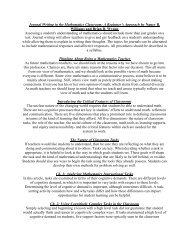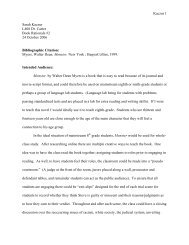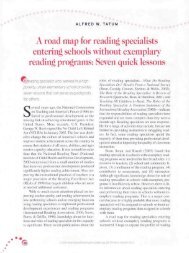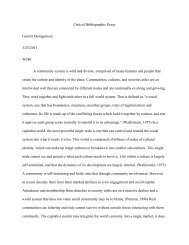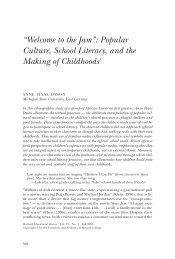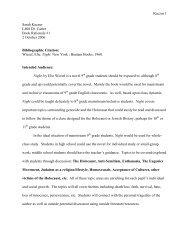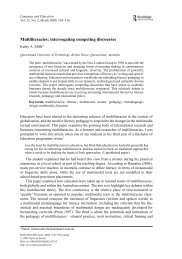Grauerholz 2003 Assessing critical thinking sociology.pdf - Oncourse
Grauerholz 2003 Assessing critical thinking sociology.pdf - Oncourse
Grauerholz 2003 Assessing critical thinking sociology.pdf - Oncourse
- No tags were found...
Create successful ePaper yourself
Turn your PDF publications into a flip-book with our unique Google optimized e-Paper software.
CRITICAL SOCIOLOGICAL THINKING 489uses ad hominem arguments."* fails to define key terms or uses circulardefinitions."* insensitive to weaknesses and contradictionsin own logic and/or evidence."* appeals to numbers or prevailing opinion(e.g., "we all know that..."; "since mostpeople think that...it follows that..."-thebandwagon rationale)."* not sensitive to questions of reliabilityand validity of evidence."* oversimplifies or misrepresents opponents'arguments-the straw person fallacy."* value assumptions left unstated and unrecognized."* cites the opinions of persons whose expertiseis dubious or undocumented.(Green and Klug 1990:470)These criteria were provided as guidelinesrather than indicators. In Green and Klug'sstudy, graders simply applied a letter gradeto the essay (e.g., "B").Another empirical study that attempted tomeasure students' sociological perspectivewas that by Bengston and Hazzard (1990).Students were asked to answer 20 questionsabout crime, family, stratification and religionthat reflected general sociological conceptsand perspectives (e.g., "The idea ofsocial class involves more than income andwealth. It also involves more subjectivenotions of power and prestige") (Bengstonand Hazzard 1990:44).In the current study, we developed empiricalmeasures of <strong>critical</strong> sociological<strong>thinking</strong>, relying heavily upon Green andKlug's (1990) criteria as well as Geertsen's(<strong>2003</strong>a) concept of referential <strong>thinking</strong>. Wedevelop and present a scale that may beuseful to researchers who are interested inmeasuring students' <strong>critical</strong> sociological<strong>thinking</strong>. We also suggest ways the scalecan be used by instructors to assess students'learning and improve their teaching.METHODSThe StudyThe data used in this study were obtainedfrom undergraduate students enrolled infour sections of a Sociology of Marriageand Family course that were taught overthree semesters. The sections were taughtby the same instructor, used identical outlinesand readings, had similar structures (acombination of lecture and discussion), andthe same number and type of exams. Onlythe type and amount of writing differed.All students across the four sections weregiven the same final exam question. Thedata used for this study come from thesefinal exams. The exam was designed to assessstudents' ability to think sociologicallyand to demonstrate <strong>critical</strong> <strong>thinking</strong>. Theessay question was as follows:One of the major principles of social psychologyis that social forces impact individualbehavior, emotions, values and attitudes andthat individuals can and do impact social institutions.Throughouthis course, we've exploredvarious ways in which this has occurredwith respect to marriage and family relationshipsin American society.Choose a relationship/family dynamic discussedin class (e.g., power, division of labor,intimacy, mate selection, communication,parenting, divorce) and discuss how this dynamiccan be understood from a social psychologicalapproach. In other words, explain howthis dynamic has been shaped by various socialforces (broadly defined) and also how individuals(or groups) have reshaped this dynamicto produce social change. For example,if you explore the dynamic of power, youwould want to discuss social factors that contributeto power dynamics in contemporarymarriages (e.g., race, class, gender norms,resources) and also how some couples havesuccessfully negotiated nontraditional powerrelationships.Your essay should include the following:1. A clear statement and description of whatdynamic you are investigating.2. A clear and concise discussion of how thisdynamic is shaped by social forces.Throughouthis discussion, be certain toincorporate points from lecture and readingto substantiate your claims, be clear aboutwhat social forces you are analyzing, and bethorough in discussing relevant forces.



